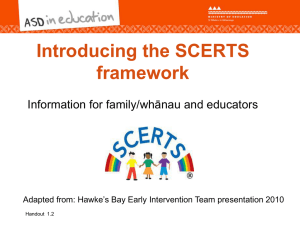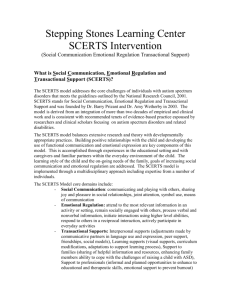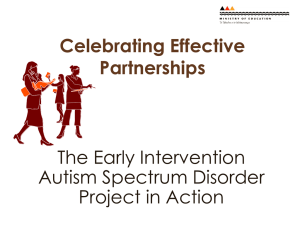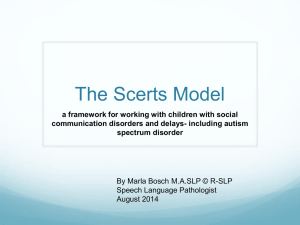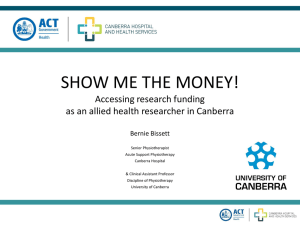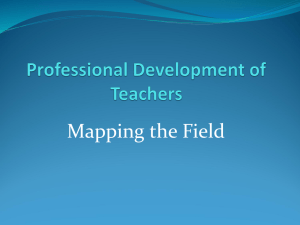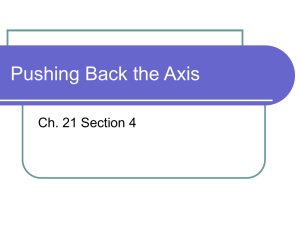A collaborative approach to building teacher knowledge, skills and
advertisement
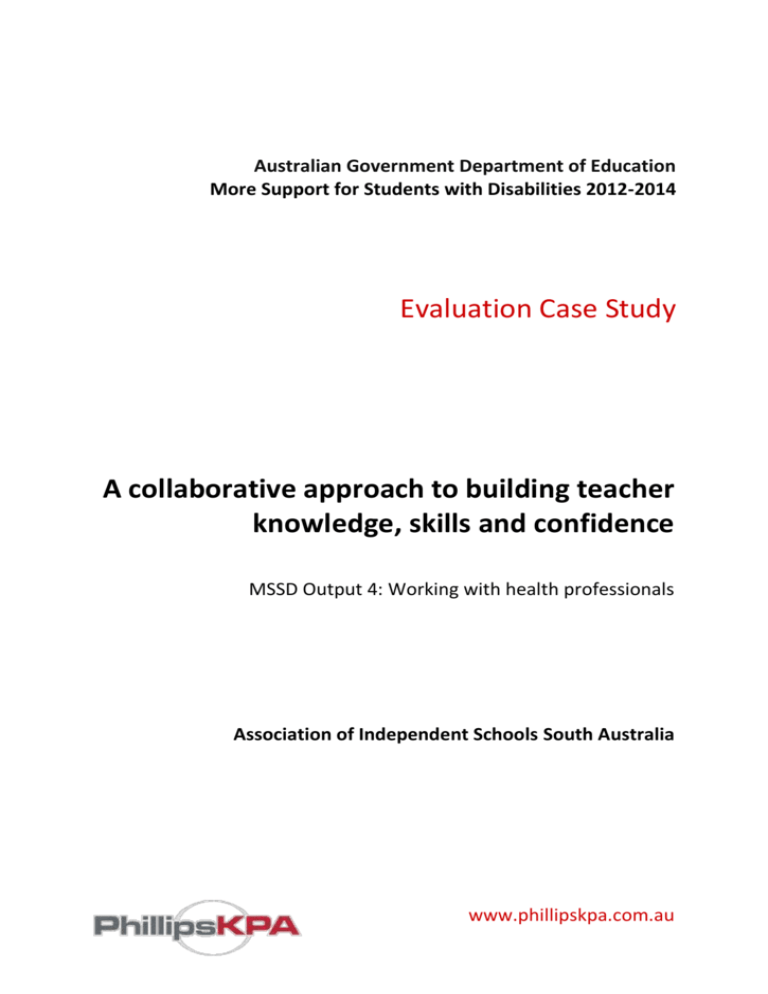
Australian Government Department of Education More Support for Students with Disabilities 2012-2014 Evaluation Case Study A collaborative approach to building teacher knowledge, skills and confidence MSSD Output 4: Working with health professionals Association of Independent Schools South Australia www.phillipskpa.com.au A collaborative approach to building teacher knowledge, skills and confidence Abstract The Association of Independent Schools South Australia (AISSA) has used More Support for Students with Disabilities (MSSD) funds to enable schools to access a range of specialist support and allied health professionals to strengthen the support for students with severe, multiple and complex disabilities. The project has a specific emphasis on building capacity in regional and rural schools. In consultation with the AISSA Special Education Adviser, schools are able to access funds to engage specialists such as a Speech Pathologist, Psychologist, Occupational Therapist, Behaviour Support Specialist and other professionals to work in partnership with teaching and support staff. The specialist provides a school-based, targeted intervention that builds school capacity to best cater for students with very complex needs. Each intervention package is tailored to complement the existing learning goals for the individual student. Key elements and actions Assessment and planning tool The SCERTS® Model is being used as an assessment and planning tool by the school. SCERTS has been developed in the United States as a research-based educational approach to address the challenges faced by children with ASD and related disabilities. SCERTS focuses on building competence across three inter-connected strands of action: social communication, emotional regulation and transactional support which constitute the SCERTS acronym: Social Communication. The development of spontaneous, functional communication, emotional expression, and secure and trusting relationships with other children and adults. Emotional Regulation. The development of the ability to maintain a well-regulated, emotional state to cope with everyday stress, and to be most available for learning and interacting. Transactional Support. The development and implementation of supports to help teachers and aides (in conjunction with parents, siblings and others) respond to the child’s needs and interests, modify and adapt the environment, and tools to enhance learning. These three strands of intervention informed the approach adopted by the independent school in establishing its programme of support for the individual student and role development and professional learning for staff. An important feature of the SCERTS approach is its applicability for individuals with a wide range of abilities and ages in diverse settings including school, home and within the broader community. For the student concerned, the home and community are considered critical to the student’s overall development, and the school is highly conscious of the need to skill the family in managing behaviours and ensure consistency across all aspects of the child’s day to day life. 2 of 8 Approach Two planning and professional learning sessions were observed during the course of the case study. The first focused on assessment and planning and the second had a combined evaluative and planning orientation. In both sessions staff were engaged in professional learning and in collaborating on roles for the remainder of the school year and into 2013. For session one, key elements included: pre-reading and reflection – overview of SCERTS and case studies; using the SCERTS Assessment Process (SAP) Observation Form to assess student’s function across the three domains: - social communication – interacting with others through sharing attention and emotion, reciprocal interaction and extent of persistence/repair regarding communication breakdowns combined with use of verbal/nonverbal symbols - emotional regulation – mutual regulation, e.g. response to assistance offered by others and/or response to feedback and guidance regarding behaviour combined with selfregulation - transactional support – interpersonal support and learning support planning goals and strategies to be implemented over the remainder of the school year combined with broader planning for the 2013 school year. As part of the pre-reading and reflection, all participating staff completed the SAP Observation Form based on their knowledge of the student in question. A major component of first session centred on these insights to achieve a shared view of the student’s skills and attributes across the three domains. Further input to this shared understanding came from two additional sources: the allied health professional’s observation of the student in a variety of contexts, including the child’s own classroom, participation in specialist programmes and in the less supervised environment of the school grounds during recess periods the child’s parent, who had also completed the SAP Observation Form based on the child’s behaviours and responses to situations at home and in the community. In relation to the latter point, parental involvement and consistent strategies across school, home and the community are considered critical to the overall success of the intervention. The outputs of the day centred on a number of actions, including: planned follow-up meetings with the child’s parents to gather further information and gain commitment to achieving a consistent approach at home and school across the three SCERTS domains identification of a small number of specific strategies to trial in the period between the next planning session such as: breathing and relaxation strategies, use of head phones and music as a time out (prior to an outburst) and counting/identification of timeframes for ‘taking turns’ planned use of Education Service Officer (ESO)/teacher aide time to complete observations of the student. 3 of 8 Session two, a half day programme included the following activities: detailed reflection on what has changed, what has been achieved and what has been learned since the first session presentation and discussion of the findings arising from the observation of the student in a number of contexts discussion regarding goals and strategies for the remainder of the year and into 2013 reflection on the efficacy of the SCERTS model as a resource to guide assessment and planning. The outputs of this process included a mix of goals and strategies across the three domains of the SCERTS model. For example, in relation to improving social communication, strategies were developed for managing the student’s “I want …” demands and to minimise outbursts that had the potential for disruption and injury to other children (emotional regulation domain). In relation to the transactional support domain, staff were to involve the parent in goal setting activity and alternative strategies for managing discipline at home (to ensure consistency with the approaches adopted by the school). In addition, the student’s 2012 teacher and 2013 teacher planned to undertake team teaching activity during the remainder of Term 4 and into Term 1, 2013 to assist in transition processes. Finally, the immediate team agreed to work with specialist and the broader staff (for yard duty purposes) to establish consistent strategies for interaction and behaviour management across the school (as they relate to the specific student). Although the SCERTS model was the key point of reference during the staff development process in Term 4, 2012, its status has become less critical during 2013. That is, while the shared understandings that were derived by using the SCERTS model across school and home for the individual student was the focus of MSSD activity in 2012, staff now have the confidence to build on this learning without the need to refer back to the details within the SCERTS model. Additionally, while it was expected to again be the key point of reference in supporting another student of equally high if not more profound complex needs in enrolling at the school, this approach has not been used during 2013. Outputs and outcomes The MSSD Initiative has delivered the following outputs and outcomes to the independent school: Professional learning. Both teaching and non-teaching staff are now skilled in the use of an intervention and planning tool with the acquired skills being applicable for use with other students. A limited train the trainer approach has been adopted in that staff involved in the intensive professional learning programme have shared understandings with other staff in the junior primary area of the school, and further training in the use of the SCERTS model has not eventuated. 4 of 8 Knowledge. Participating staff have a shared understanding of an individual student’s strengths and attributes as well as knowledge of a range of behaviour and gaps in development that have been systematically mapped against the SCERTS Observation criteria. The knowledge accumulated about the individual student — the focus of the initial professional learning programme — has been shared with his current teacher. This knowledge and associated strategies have both proven to be highly valuable and effective in managing behaviours and sustaining engagement in learning. Planning. Through the professional learning, staff now have a plan of action that features a mix of goals and strategies with a particular focus on minimising issues in the transition from the 2012 to the 2013 school year. For the individual student, the plan of action has been implemented effectively during the 2013 school year to the point where the student is no longer a ‘group of one’ in the class. Rather, he is now part of a small group of students with specific learning needs where adjustments are generally made for the group as a whole rather than on an individual basis. In particular, the student’s emotional regulation has been significantly strengthened – behavioural outbursts are less frequent and less violent when they occur. As a consequence, planning for the student centres almost entirely on the academic rather than the social/emotional domain. Role development. Teachers discussing and planning options for team teaching and for nonteaching staff are assuming a more strategic role in undertaking structured observations of students. They are providing the insights gained through this process to teachers to support intervention and teaching strategies. Role development that occurred in 2012 carried forward into 2013 in respect of staff being confident in undertaking their broader roles within the school. This is most apparent in the case of the two Education Support Officers who are highly regarded for their knowledge and skills. While the use of the SCERTS framework has not continued within the school, the Education Support Officers who were involved in training in the use of the resource are an important resource in the school. In effect, they are the value adding resource, rather than the documented framework, for analysing the learning needs of children on the Autism Spectrum Disorder. Family engagement. Although a number of issues remain in regard to parental expectations and response to certain behaviours, there is a clear willingness amongst the staff to test ideas to achieve a level of consistency across school, home and the community. All staff acknowledge that family engagement was a critical component of the planned approach to supporting the student. Lessons learned Key observations The contrast between the two observed planning and professional learning sessions was quite noticeable. In the first session discussion centred primarily around the challenges and issues in relation to understanding the highly complex nature of the child’s learning needs and family circumstances. While all staff were universally committed to improving the educational experience for the student and others in the class, there was a sense that the challenges were so profound that survival and coping strategies were the main focus of much of the discussion. By the second session, 5 of 8 although issues and challenges were still prominent, it was obvious that staff had been empowered and demonstrated a clear sense of direction. In the return visit in November 2013, the positive and purposeful approach to the learning needs of students with disabilities within the school remained most apparent. Staff spoke with confidence and an element of pride in the way that the student who was the focus of planning in 2012 had progressed and in their own capabilities in supporting students with disabilities more generally. Sustainability The approach is showing early signs that it is likely to have a sustained impact. The allied health professional provided notes to the school that points to success in the long-term: ... You have a process now that you can work on for new students to the school … you will not need me to help you with that if you apply the same approach … if you put these things in place as reminders, it will help you stay on track … School staff share this view: ... the SCERTS programme has provided us with a model that has allowed us to gain specific and helpful information in supporting (student)… this model and successful experience will be used with other students and staff at our school. The value of the role of the allied health professional as facilitator of change cannot be underestimated. The participating staff now have enhanced capabilities – knowledge, skills and confidence – and they have also retained ownership of what is to be implemented. They will not be dependent on the support of the allied health professional in the future. The commitment of staff to addressing the learning needs of the student is clear. What was achieved prior to the injection of MSSD support largely occurred through a process of trial and error and perseverance by the staff concerned. The SCERTS model was an initial point of reference, a plan of action and framework for monitoring impact. Staff now have the capability to replicate the approach with other students with similar needs. A question remains as to the long-term impact of the professional learning experienced by a small group of staff on improved knowledge and skills across the remainder of the school. Determining the extent to which professional learning for a small group of staff translates into improvements in practices across a whole school is a specific objective of the model. The case study provided the opportunity to assess the nature and extent of skills transference across the school over the first 12 months. Skills transference has been mixed. Within the junior primary area of the school skills and knowledge are clearly being shared to the benefit of the students with disability who are enrolled in this area of the school. What is less apparent is the use of SCERTS as a point of reference in the skills transference that has occurred. Indeed, the special education team has only made use of the resource once in the last six months as part of a reflection exercise to evaluate the status of the focus student across the three domains of Social Communication, Emotional Regulation and Transactional Support. It was suggested that the anticipated use of SCERTS to support the enrolment of another student with multiple and complex needs did not eventuate largely because of the availability of a range of allied health services providing support to the school as the student makes that transition to formal schooling. That is, through resourcing accessed via the Better Start initiative and the South Australian Association of Independent Schools, allied health professionals from Autism SA, Novita 6 of 8 Children’s Services and a private occupational therapist have been visiting the school on a fee for services basis. It is noteworthy that these arrangements contrast markedly with previous service delivery model generally experienced by the school when allied health professionals have been engaged. Being based in a regional location, the school has had limited access to allied health professionals in the past. Where services have been provided, they have been limited to assessments of students and the provision of a report of varying levels of usefulness. By contrast, the current service arrangements are based on a consultancy model in which the allied health professionals work with students and staff in classrooms to provide practical advice and resources to support engagement in learning. As the school’s special education coordinator notes, [The] visiting allied health services provide practical, expert guidance to staff and the student’s family to assist with social development and engagement with learning. Staff acknowledge that the additional funding, while appreciated, is not necessarily ongoing and therefore they see the SCERTS model as a resource to fall back as required when the allied health support is no longer available. Potential for adoption in other contexts The AISSA approach to Output 4 has strong potential for adoption or adaptation in other settings. The key to undertaking such an exercise centres on a judgment about the level of investment required. The school has been able to establish a professional learning and planning process that would previously not have been contemplated due to the costs associated, specifically for teacher release and engagement of an allied health professional to deliver the professional learning to a small group of staff. Based on the cumulative feedback received from key participants and stakeholder it was universally agreed in the 2012 site visits that the MSSD Initiative funds had been well spent. Follow up consultations 12 months after the initial visits suggest that this view remains accurate. There was less support for the ongoing use of SCERTS as a point of reference as a planning tool for meeting the educational needs of a student with multiple and complete disabilities. Rather, the investment in the professional learning of a team of staff, facilitated by an allied health professional (who happened to use SCERTS as a frame of reference for the professional learning) continues to pay dividends for the school. The lessons learned from this approach have not been lost on the school’s leadership. The school’s principal has indicated that he would readily apply the same model of professional learning because of the benefits that have accrued through strengthening the student support team as a whole – thereby enhancing collective capabilities and the capacity of the school to support students with high levels of complex disability. 7 of 8 Background MSSD Output Output 4: Schools coordinating with health/allied health or other professionals to strengthen schools’ support for students with disabilities. Case study methodology The methodology involved interviews in September 2012 with the MSSD manager from the Association of Independent Schools South Australia (AISSA), the allied health professional working with the school, and the special education teacher from the case study school. This provided an overview of the approach to be adopted by the allied health professional. Two school site visits were conducted in 2012. The first visit in November 2012 included observations and discussions with school staff during a set aside for professional learning. This site visit included an initial meeting with the school principal. A second follow up visit in early December 2012 provided insights into the extent to which the outputs of the initial day had been successfully implemented, any barriers that might have emerged, and plans for the remainder of 2012 and early 2013. A return visit to the school in October 2013 provided the opportunity to establish a longitudinal perspective on the change process which has evolved at the school since the inception of MSSD activity in 2012. Description of activity The model of support has been developed by the allied health professional in collaboration with key school staff. It centres on a widening spiral of growth in knowledge, skills and confidence focused initially on a small group of staff and then the engagement of the whole school in the development of these attributes. The model is designed around the needs of one student on the Autism Spectrum Disorder (ASD). His needs are extremely complex - with a disruptive and traumatised early life. He presents with a range of behavioural difficulties that are at times difficult to manage, but in respect of the purpose of this case study, they are not the focus. The case study is about the development of a model for professional learning and the processes that unfold as a result rather than the process to address the social and learning needs of an individual student. The school team involved in the initial implementation of the model comprises: the special education teacher, the current class teacher and the class teacher for the following year two education support officers who have mixed roles in the school covering in-class support and delivery of small group and one-to-one interventions. 8 of 8
